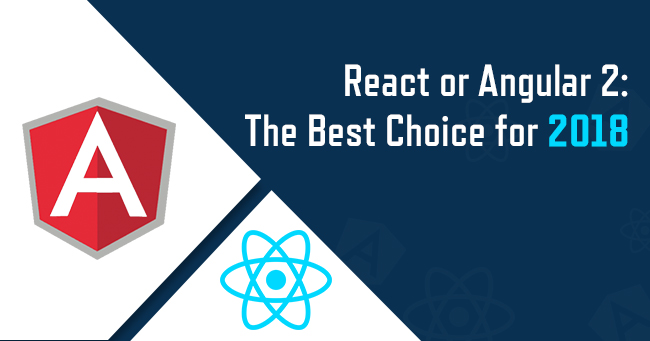Currently, web designing is taking a splash with the new JavaScript technologies. Every year, new technologies come in and old ones fade out. Programmers have to be adaptable to pick and choose relevant new technologies. Also, businesses have to be quick to try the new technologies in the town. Choosing the right framework is important for both. Angular 2 and React are the two torchbearers for front-end development in 2018.

Angular is a platform for building web applications by Google. While React is a JavaScript library for building and creating UI by Facebook. Let us now quickly jump to the battle of React vs Angular 2.
| Technology | React JS | Angular JS |
| Language | JavaScript | JavaScript |
| Complexity | High | Low |
| Architecture | Component Based | Flux |
| DOM | Virtual DOM | Real DOM |
| Type | Open Source JS library | Fully-featured MVC framework |
| Development Time | High | Low |
| Learning Curve | Low | Medium |
| Rendering | Fast | Slow |
| Community | Bigger | Smaller |
| Popularity | High | Medium |
1. Templates
Both React and Angular 2 are based on JavaScript.
Angular 2 is in TypeScript. The templating is done with the HTML files. It follows the object-based programming patterns. Due to this, Angular 2 has high-performance typing features. Angular 2 put JavaScript into HTML. It is HTML-centric.
Everything in React is in JavaScript XML(JSX). It has a JS syntax that enables HTML quotes. It promotes the building of machine-readable code. The templates and logic of React are written in JSX. The syntax of React is simple and clean. React puts HTML into JavaScript. Thus, it is JavaScript-centric.
2. Framework
Angular 2 is a full-fledged framework. This framework can run on any platform or browser. It has other advantages such as it is consistent, offers a lot of ready-made tools. Moreover, the ng components are quite mature and robust.
ReactJS is not a full-scale framework. Due to which the integration of the UI library into the common MVC framework becomes tricky. This requires a deeper programming knowledge. ReactJS is still fresh and not mature. Taking consideration of the limited ecosystem, it is still young.
3. Architecture
Angular 2 and React follow different architectures. Angular 2 follows a component-based architecture. The components have a strong and deep binding. As Angular 2 is an object-oriented programming, the elements are properly encapsulated. Every element in the component has its unique functionality. This makes the components reusable and properly testable.
While React does not follow any such architecture, it uses Flux which provides a structure and architecture. It gives a unidirectional data flow to the components. Flux is more of a pattern than a framework. Thus, using flux with React makes the coding easier and flexible.
4. DOM
DOM(Document Object Model) is one of the major difference to point out when using React or Angular 2.
Angular 2 manipulates the real DOM by extending HTML with its directives. This enhances the two-way-data binding. Thus, any changes to the view will reflect in the data and vice versa. This turns out to be an advantage for the developers, increasing the development time. And it enables the auto-sync between the model data and the view.
React on the other side uses the virtual DOM. The Virtual DOM is of great use while handling large databases. It comprises of the smart methods. With React, the view changes are applied to virtual DOM. This optimizes and accelerates the update process.
5. MVC
Angular 2 follows the MVC pattern. Thus it has a proper component-based architecture. It has a clean separation of the presentation, business and data entity model. This allows a proper testing of written code. This makes Angular 2 out-of-the-box programming language.
React does not follow the MVC pattern. It does not have patterns, templates or any MVC architecture. Instead, it has view layer only. Developers need to solve the Model and Controller on their own to design the app. They have to be familiar with the component’s life cycles and states.
6. Development Time
Developers are always fascinated with how the language works, how short is the learning curve and the overall development time.
Angular 2 is a complex component-based language. It has a quick installation and setup. But it has unnecessary syntax to do simple things. Thus, there is a drastic increase in development time. This puts Angular in a tougher position.
React takes comparatively longer to set up. And once done, you are ready to work on the app development. It should be relatively easy to add new features.
7. Learning Curve
Angular 2 has a steep learning curve. Though the Angular 2 community provides a complete documentation. But sometimes it becomes difficult to read the documentation. Angular 2 focuses more on the components. But it is comparatively difficult than React.
React has a short learning curve. It uses the least abstractions. However, it takes more time to learn the best practices. It has too many things to learn in depth.
8. Native Rendering
This is always the talk around the tables. All libraries are capable of native rendering. But there is always a performance competition among all the libraries.
Angular 2 is the stable version with the new addition of components. It comes with a native script. However, it still fails to beat the performance of react native.
React native comes with the native rendering. It does it better than the Angular 2.
9. Community
The community support plays a huge role in the success of these languages. Both have powerful communities.
The global community support of Angular 2 makes it one of the best Javascript frameworks. The developer team, designers, support team – actively work behind its success. They work with collaboration, contributing to the community. Angular 2 has hence boasted of huge reliability and credibility.
Facebook and Instagram both support react. The experts and developers work constantly to make this technology worth. Users can find active participation in online forums such as Stack Overflow, GitHub, Reactiflux Chart and many others.
10. Global Usage and Popularity
Thousands of companies worldwide have chosen the rich JavaScript frameworks. They use it for their sites, apps and internal projects. Angular 2 is popular among many leading sites. Google, the main force behind it also encourages its use. It powers The Guardian, PayPal, Lego, Netflix and other leading sites.
Many Fortune companies and startups have chosen React native for their app development. Instagram, Facebook, Dropbox, Tesla, Khan Academy and more such leading brands use this. React is very popular among many startups as well.
There is no doubt that both are advanced and high demand technologies in 2018. However, the developer’s choice depends on the requirements and the system constraints.
In 2018, there will be a rise in the creation of native apps. With Angular 4, there are possibilities in this area of huge improvement. 2018 will reveal whether Angular 4 will break through the domination of React or not.
Contact us to know more about our comprehensive Angular and React development services today!

